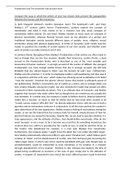Frankenstein and The handmaid’s tale practice essay
Compare the ways in which the writers of your two chosen texts present the juxtaposition
between the human and the monstrous.
In both Margaret Atwood’s modern dystopian novel ‘The handmaid’s tale’, and Mary
Shelley’s 17th century gothic horror ‘Frankenstein’, authors explore the concept of
monstrosity and what it truly means to be a monster, but also social concepts of
monstrosity within society. On one hand, Shelley chooses to focus more on concepts of
physical monstrosity, whereas Atwood focuses more on the attitudes of a puritan and
traditional dystopian society towards different types of people; races, religions, sexual
orientation (along with physical appearance). In terms of humanity, both novels lead the
reader to question the morality of certain aspects of our own society, and whether some
parts of society can make monsters out of men.
A common theme throughout Mary Shelley’s Frankenstein is that victims are often made to
feel as though they are the true monster, despite their innocence. Justine Moritz, a loyal
servant to the Frankenstein family, who is described as one of the ‘most amiable and
benevolent of human creatures’, is wrongly accused of the murder of William; the youngest
Frankenstein son. Even though Justine knows that she is wrongly accused, she still tells
Elizabeth that she ‘almost began to think I was the monster he said I was’. Furthermore,
Shelley uses the pronoun ‘I’ in order to emphasise Justine’s self-questioning, but also uses it
in conjunction with the verb ‘was’, which makes her phrasing sound so definitive in its belief
‘I was the monster’. However the adverb ‘almost’ shows that Justine is ultimately aware of
her guiltlessness. Shelley’s constructive use of Justine as a victim, who is wrongly killed, not
only creates empathy among the reader, but also reminds the reader that people are often
convinced of their monstrosity by others. This is an ultimate flaw of humanity, and Shelley
suggests that humans who make others feel as though they are monstrous are actually the
true monsters. In a similar way, the creature is made to believe that his ‘physical deformity’
makes him a monster, so much so that he wishes that he had never been created at all
‘Cursed, cursed, creator! Why did I live?’ he directly addresses Victor, with the use of both a
question and an exclamatory sentence in conjunction, to all the more portray the creature’s
utter abhorrence of his own appearance. Shelley creates a feeling of real sadness among the
reader, as we see the hatred that the creature feels for himself, simply because of how his
physical features are viewed by humanity. Despite this, we are lead to question whether it is
truly appearances, and the attitudes of others, that should define monstrosity. After all, the
word ‘monster’ is not a noun, to be a monster you must first do something monstrous; the
creature does not, until he is provoked by the cruelty of man. It could be said that Victor, as
the creator who abandoned his creature, is a man who displays true monstrosity.
Furthermore, the creature states ‘I ought to be thy Adam but I am rather the fallen angel’,
here Shelley intertextually references Milton’s epic poem ‘Paradise lost’, which follows god’s
creation of ‘Adam’ and his abandonment of Lucifer, who then betrayed god, becoming the
‘fallen angel’ Satan. In which case Victor could be paralleled with god, who though seen as
omnibenevolent, could be interpreted as truly monstrous in his creation of a monster
through abandonment of his creation. Similarly to this, Atwood also explores the idea of
people being conditioned as monsters in the eyes of god, simply due to the attitudes of
society. In chapter 45, towards the very end of the novel, Offred has been made to feel that





